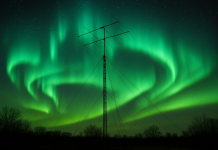
astronomers working at an Australian observatory picked up a series of fleeting but powerful radio signals. These signals have never been detected elsewhere, casting doubts on their origin. But now, new observations from the Arecibo Observatory in Puerto Rico suggest they’re for real.
Up until this point, the only observatory to detect these signals has been the Parkes radio telescope in New South Wales, Australia. The dozen-or-so bursts that appeared in 2011-12 likely originated from outside the galaxy. In just a few milliseconds, each of the radio bursts released as much energy as the sun emits in 300,000 years.
Astronomers have all kinds of theories as to what may be triggering the bursts, including blitzars — overweight neutron stars that are resisting the urge to turn into a black hole on account of their rapid rotation. Other theories include magnetars, which are neutron stars with super-strong magnetic fields, evaporating black holes, and gamma ray bursts that involve a supernova.
The new observations were made at Arecibo on November 2, 2012, home to the world’s largest single-dish radio. The data showed a massive 3-millisecond spike, but unlike radio blasts produced by some pulsars, the burst did not recur.
BRIGHTNESS, DURATION AND INFERRED EVENT RATE ARE ALL CONSISTENT WITH THE PROPERTIES OF THE PREVIOUSLY DETECTED PARKES BURSTS. COULD THEY HAVE AN ALIEN ORIGIN?
Much more at NatGeo.












